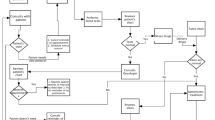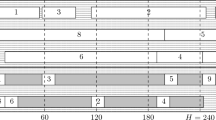Abstract
The oncology clinics use different nursing care delivery models to provide chemotherapy treatment to cancer patients. Functional and primary care delivery models are the most commonly used methods in the clinics. In functional care delivery model, patients are scheduled for a chemotherapy appointment without considering availabilities of individual nurses, and nurses are assigned to patients according to patient acuities, nursing skill, and patient mix on a given day after the appointment schedule is determined. Patients might be treated by different nurses on different days of their treatment. In primary care delivery model, each patient is assigned to a primary nurse, and the patients are scheduled to be seen by the same nurse every time they come to the clinic for treatment. However, these clinics might experience high variability in daily nurse workload due to treatment protocols that should be followed strictly. In that case, part-time nurses can be utilized to share the excess workload of the primary nurses. The aim of this study is to develop optimization methods to reduce the time spent for nurse assignment and patient scheduling in oncology clinics that use different nursing care delivery models. For the functional delivery model, a multiobjective optimization model with the objectives of minimizing patient waiting times and nurse overtime is proposed to solve the nurse assignment problem. For the primary care delivery model, another multiobjective optimization model with the objectives of minimizing total overtime and total excess workload is proposed to solve the patient scheduling problem. Spreadsheet-based optimization tools are developed for easy implementation. Computational results show that the proposed models provide multiple nondominated solutions, which can be used to determine the optimal staffing levels.













Similar content being viewed by others
References
Burke EK, De Causmaecker P, Vanden Berghe G, Van Landeghem H (2004) The state of the art of nurse rostering. J Sched 7:441–499
Chabot G, Fox M (2005) The creation of a patient-classification system in an outpatient infusion center setting. Oncol Nurs Forum 32(3):535–538
Diedrich J, Pawlik-Plank DM (2003) Efficient system to schedule chemotherapy and support therapies for oncology nurses. In: Oncology Nursing Society Congress Abstracts, Abstract 76
Dobish R (2003) Next-day chemotherapy scheduling: a multidisciplinary approach to solving workload issues in a tertiary oncology center. J Oncological Pharm Pract 9:37–42
Gaits VA (2005) Nurse resource allocation in ambulatory cancer centers: guidelines for clinicians and executives. Oncology Issues pp 36–42
Gruber M, Kane K, Flack L, Abbotoy J, Recchio J , Williamson K, Horan K , McCarthy P (2003) A perfect day work redesign in a chemotherapy and infusion center. Oncol Nurs Forum 30(4):567–568
Hahn-Goldberg S, Carter MW, Beck JC, Trudeau M, Sousa P, Beattie K (2014) Dynamic optimization of chemotherapy outpatient scheduling with uncertainty. Health Care Management Science 17(4):379–392
Hawley E, Carter NG (2009) An acuity rating system for infusion center nurse staffing: The Cleveland Clinic Cancer Center at Hillcrest Hospital experience. Oncology Issues November/December:34–37
Ireland A, DePalma J, Arneson L, Stark L, Williamson J (2004) The Oncology Nursing Society ambulatory office nurse survey. Oncol Nursing Forum 31(6):E147–E156
Langhorn M, Morrison C (2001) Redesigning processes in ambulatory chemotherapy: Creating a patient appointment scheduling system: Part II. Canadian Oncol Nursing J 11(3):157– 159
Mason A, Dunning I (2010) Opensolver: open source optimisation for excel. In: Proceedings of the 45th annual conference of the ORSNZ, pp 181–190
Mullinax C, Lawley M (2002) Assigning patients to nurses in neonatal intensive care. J. Oper. Res. Soc. 53:25–35
Oncology Nursing Forum (2004) Medicare Reimbursement for Chemotherapy Administration and Related Practice Expenses, Issue Brief
OpenSolver (2014). http://opensolver.org
Punnakitikashem P, Rosenberger J, Behan D, Baker R, Goss K (2006) An optimization-based prototype for nurse assignment. In: Proceedings of the 7th Asian Pacific industrial engineering and management systems conference, pp 17–20
Punnakitikashem P, Rosenberger JM, Buckley-Behan D (2008) Stochastic programming for nurse assignment. Comput Optim Appl 40(3):321–349
Rosenberger JM, Green DB, Keeling B, Turpin PG, Zhang JM (2004) Optimizing nurse assignment. In: Proceedings of the 16th annual society for health systems management engineering forum
Sadki A, Xie X, Chauvin F (2011) Appointment scheduling of oncology outpatients. In: IEEE Conference on Automation Science and Engineering (CASE), pp. 513–518
Santibáñez P, Aristizabal R, Puterman ML, Chow VS, Huang W, Kollmannsberger C, Nordin T, Runzer N, Tyldesley S (2012) Operations research methods improve chemotherapy patient appointment scheduling. Jt Comm J Qual Patient Saf 38(12):541–553
Schaus P, Van Hentenryck P, Régin J-C (2009) Scalable load balancing in nurse to patient assignment problems Integration of AI and OR Techniques in Constraint Programming for Combinatorial Optimization Problems. Springer, Berlin, pp 248–262
Sevinc S, Sanli UA, Goker E (2013) Algorithms for scheduling of chemotherapy plans. Comput Biol Med 43(12):2103–2109
Shashaani S (2011) Chemotherapy patient scheduling and uncertainty. Master’s thesis, Purdue University
Sundaramoorthi D, Chen VCP, Rosenberger JM, Kim SB, Buckley-Behan DF (2009) A data-integrated simulation model to evaluate nurse–patient assignments. Health Care Manag Sci 12(3):252–268
Turkcan A, Zeng B, Lawley M (2012) Chemotherapy operations planning and scheduling. IIE Trans Healthc Syst Eng 2(1):31–49
West S, Sherer M (2009) The “right” nurse staffing model. Oncology Issues, pp 26–30
Zitzler E (1999) Evolutionary algorithms for multiobjective optimization: Methods and applications. PhD thesis, Swiss Federal Institute of Technology Zurich
Author information
Authors and Affiliations
Corresponding author
Rights and permissions
About this article
Cite this article
Liang, B., Turkcan, A. Acuity-based nurse assignment and patient scheduling in oncology clinics. Health Care Manag Sci 19, 207–226 (2016). https://doi.org/10.1007/s10729-014-9313-z
Received:
Accepted:
Published:
Issue Date:
DOI: https://doi.org/10.1007/s10729-014-9313-z




